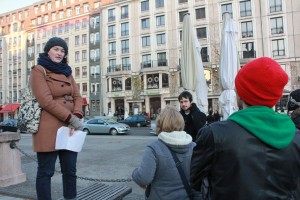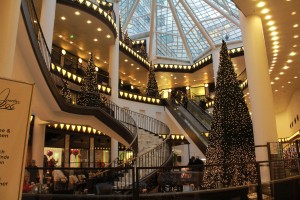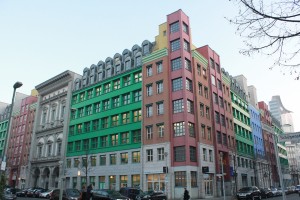A tour of Critical Reconstruction in Mitte with Nara
This week, I took the students on a tour focusing around the reconstruction of Mitte, the central district of Berlin. The guiding principle for this has been the concept of “Critical Reconsruction,” a set of city planning and architectural approaches that emphasize traditionalism and history.
One of the amazing things about this approach is the way that different architects have responded to the task: in Pei Cobb Freed’s Quartier 206 building, for instance, the idea of a turn-of-the-century shopping gallery has been combined with modern materials and geometries to create a rich amalgam of yesterday and today.
The same can be said for this building by Aldo Rossi. Rossi’s writing was incredibly influential on Critical Reconstruction theory, because he emphasized issues of memory – not only official, public memory, but personal and dream-like memory – in his work. As we’ve seen this quarter, Berlin is nothing if not memory-laden …
As visually appealing as much of Critical Reconstruction is, there are also problems with it. One of these is the rhetoric used by planners and architects in order to push certain projects through. Spaces such as Alexanderplatz – remodeled thoroughly in the 1960s – were dubbed “totalitarian” or “socialist,” when they actually embodied architectural types that were typical of Western architecture. This kind of language masks the real target of Critical Reconstruction: the Modernist architecture that preceded it!
As we move into an exploration of Berlin’s contemporary issues, the rifts in the various discourses about identity and space will continue to become more and more apparent.
*Special thanks to Ryna Chin for the great photos!
tags
the author
I'm a doctoral student at CUNY Graduate Center. I'm thrilled to be teaching the CHID Berlin program with Prof. John Toews! You can contact me at naraelle [at] gmail.com, or find out more about me at www.naraelle.net.
Blogroll
- Annie Holden's blog
- Cassie Hoeprich's blog
- Dominic Barrera's blog
- Janet Williams's blog
- Mariah Alderete's blog
- Melissa Au's blog
- Robert Hampton's blog
- UW Students Study Abroad Our students Natalie and Cassie are contributing to the official IPE student blog this fall!






